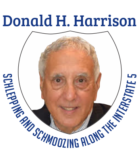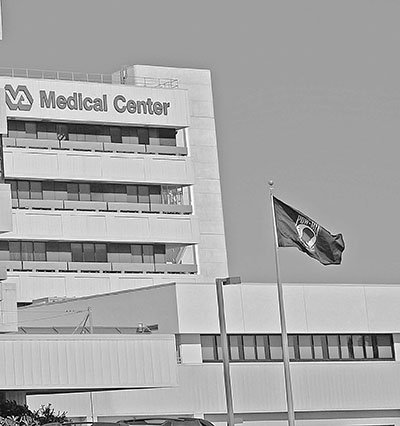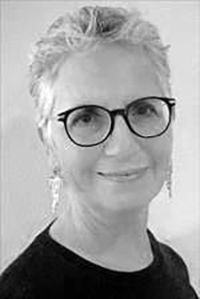 Editor’s Note: This is the 17th chapter of Volume 2 of Editor Emeritus Donald H. Harrison’s 2022 trilogy, “Schlepping and Schmoozing Along the Interstate 5.” All three books may be purchased from Amazon.com. Harrison may be contacted via Amazon.com.
Editor’s Note: This is the 17th chapter of Volume 2 of Editor Emeritus Donald H. Harrison’s 2022 trilogy, “Schlepping and Schmoozing Along the Interstate 5.” All three books may be purchased from Amazon.com. Harrison may be contacted via Amazon.com.
Schlepping and Schmoozing Along the Interstate 5, Exit 28B (La Jolla Village Drive): Jennifer Moreno Department of Veterans Affairs Medical Center.
From northbound Interstate 5, take Exit 28 B (La Jolla Village Drive) and turn left. Make a right turn on Villa La Jolla Drive. The Jennifer Moreno Department of Veteran Affairs Medical Center is on the right at 3350 La Jolla Village Drive. (The VA Medical Center was renamed in 2022 for Army Capt. Jennifer Moreno, a 25-year-old nurse who was killed Oct. 5, 2013, while trying to help a fellow soldier wounded in a suicide bombing attack. It is the first VA facility to be named for a Latina.) UC San Diego’s Biomedical Research Facility is on the left.


LA JOLLA, California — Sonia Ancoli Israel is a recognized authority on the subject of sleep. That’s something that we all do, but most of us don’t know how important it is or why the world-renowned researcher urges everyone to “prioritize sleep.”
We previously met Israel in our chapter about Congregation Beth El, where the daughter of Holocaust survivors had served as president. She started her sleep research in the 1980s at UC San Diego and the Veterans Administration Medical Center. Armed with a doctorate in psychology from UC San Francisco, where she had studied with renowned sleep researcher Irwin Feinberg, she sought an academic appointment with San Diego sleep researcher Dan Kripke, a psychiatrist. Kripke responded that he didn’t have a paid position for her, but said, “I have a desk and a phone.” It was the perfect place from which Israel successfully applied for a grant from the National Institutes of Mental Health to study the relationship between sleep and aging.
Even though she soon became a member of the UC San Diego faculty, Israel continued to work from the V.A., where she had access not only to that desk and phone, but also to a sleep laboratory, which then consisted of two rooms. In one, the patient was hooked up to a polysomnogram (PSG) with electrodes placed to monitor movements of the head, eyes, chin, and legs. While the patient slept, “you record heart rate, respiration, leg movement, oxygenation – those re the basics,” Israel said. “Often there is a video recording as well and we look for any unusual movements.”
In the other room stood a three-foot wide, floor-to-ceiling polygraph machine that recorded the patient’s progress. During the night pens recording the patient’s sleep would typically trace rhythmic lines across a sheet of paper at the bottom of the machine. However, Israel recalled, “when something exciting was happening, the pens would really go wild, and you would get covered with ink. We wore white coats!”

In addition to the observations she made of patients in her laboratory, Israel also went to nursing homes to make a more portable type of recording. She used an actigraph, which resembles a large wristwatch, to measure wrist movement. “It is very sophisticated. From that movement, you can estimate wake and sleep … They (study participants) were connected via a wire to a little cassette tape recorder, and we would record movement and respiration and leg movements. We did that with over 600 community-dwelling elderly, and we also did it in nursing homes.” Among the venues where Israel conducted studies were the former San Diego Hebrew Home for the Aged on 54th Street and its successor residence for older adults, Seacrest Village Retirement Community in Encinitas.
That first study looked at the prevalence of sleep apnea among older adults. “Sleep apnea is a disorder when people stop breathing in their sleep,” Israel explained. “The airway collapses and they can’t breathe, so they wake up, start breathing, go back to sleep, and then they stop breathing again. This goes on for periods throughout the night. Obviously when they stop breathing, they don’t get oxygen to their brain and their sleep is very disrupted, so between these two things, you get different side effects.”
Hypertension, greater risk of stroke, snoring, confusion, and daytime sleepiness are all side effects of sleep apnea, Israel said. There are several theories about what causes sleep apnea: “One has to do with anatomical changes in airways that come with age. Some have suggested change in hormones, certainly with women as we lose our estrogen. Estrogen seems to be more protective. Sleep apnea is always more common in men than women, no matter what the age, but post-menopausal women have much more sleep apnea than pre-menopausal.”
Israel decided to investigate “how much of the symptoms we see in older adults might really be because of sleep apnea. How common was sleep apnea in older adults? We also looked at another sleep disorder called ‘periodic limb movements in sleep’ – people who jerk their leg every 20 to 40 seconds throughout the night. So, we recorded leg movement, respiration, and the wrist movement in order to tell when they were awake and when they were sleeping.”
Based on the studies, she estimated that 60 percent of older adults suffer at least a minimal amount of sleep apnea.
This study led to another concerning the relationship between sleep and Alzheimer’s disease.
“Loss of memory is one of the symptoms of sleep apnea, so to me that was a crucial question: how much of the symptoms that you were seeing in dementia were because of sleep apnea? But the first thing we established is how common it is. What we found in Alzheimer’s, in demented older adults, was that it was even more common than in other older adults. We found as much as 90 percent, which is essentially everybody, had sleep apnea in a nursing home.
“The next question I wanted to answer was ‘what if we treated sleep apnea? What will that do to the memory and to the symptoms?’ I couldn’t do that in the nursing home – once you are severely demented it is less likely that you will tolerate the treatment,” which is called “Continuous Positive Airway Pressure (CPAP).”
“It is a mask connected via hose to a machine that pushes positive pressure through the airway, which acts like a splint to keep the airway open during the night,” Israel explained. “So, when you fall asleep the airway doesn’t collapse. It stays open and you can breathe, and you can sleep.”
Instead of in nursing homes, she studied patients with sleep apnea and mild to moderate dementia who were still living at home. One group received the CPAP treatment, another group received a sham CPAP treatment. “What we found was those who were treated with real CPAP had less sleep apnea, deeper sleep, slept better, got more oxygen during the night, and improved their cognitive function.” While the treatment didn’t cure Alzheimer’s, it allowed patients to return to their baseline cognition more quickly than patients who experienced sleep apnea during the night.”
Alzheimer patients who continued to receive the CPAP treatment for six months, “still were getting worse, but it was at a much slower rate than the others,” Israel said.
Ironically, it was Alzheimer’s that took the life in 2020 of her husband of 41 years, Andrew G. Israel, M.D., an active physician at Mercy Hospital and the founder of the Hillcrest Internal Medicine practice. “Towards the end, when he was in hospice, his sleep was very disrupted as is typical in severe Alzheimer’s,” she recalled. “The hospice nurse recommended a treatment with a cream containing Ativan, Haldol, and Benadryl, three drugs that Israel had recommended against using on patients during earlier phases of the disease. “My mouth literally dropped when she said this: ‘Are you kid—’ and I stopped midsentence, and I said, ‘You know what? I am going to take off my professional hat and I am going to put on my caregiver hat, and I am going to listen to you. This is hospice (where palliative care is provided to terminally ill patients.) It is a whole different thing. We used the cream, and it calmed him down a little bit.”
“You have to be more flexible when you are a caregiver,” she concluded from that experience. “Doing individual care is different than when you are doing research on a larger scale. So, it was very eye-opening, a humbling experience.”
Another area of research for Sonia Ancoli Israel was the relationship of sleep to breast cancer.
“The cancer work started when some of my colleagues started publishing on the fact that if you time chemotherapy to the circadian rhythm (our 24-hour biological rhythms, including sleep and wakefulness), you can give higher doses with fewer side effects. I thought wow, this is really impressive. But I realized we knew very little about circadian rhythms in patients with cancer. So, I began looking at circadian rhythms and the relationship among sleep, fatigue, and rhythms in women with breast cancer. One of the things that I did that was different from anyone else was that I was studying those women before they started their chemotherapy. Everyone else had looked primarily at survivors, or during chemo, but how can you know what is going on during chemo if you don’t understand what was going on before they started chemo?”
Israel’s research found that symptoms like not sleeping well and fatigue worsened while patients were going through a course of chemotherapy.
Generally, chemotherapy for breast cancer patients is given in cycles. “You get it in the first week and you have a week or two off, and then in the fourth week, you get chemo again, and you have a week or two off, and those are the cycles,” she said. “What we found was that in the first cycle, the rhythms got very disrupted during the week of chemo, but during the second and third week, they recovered to baseline levels. By the fourth cycle of chemo, they got worse during chemo, and they tried to recover but they couldn’t.
“What that meant was the more chemo you had, the worse and the more enduring the circadian rhythm disruption was. The reason I thought that was important was that we know from other studies – mostly epidemiological studies –that having poor rhythms increases the risks of Alzheimer’s, of cancer, and mortality. We knew how to fix rhythms—with bright light. So, to me the next step was, well, what if we use bright light? Can we help the fatigue and the sleep? We got funded to test this. We gave women morning bright white light, using dim red light as a comparison group, and we found that the bright white light did in fact keep the rhythms from getting disrupted, kept the fatigue from getting worse, and improved quality of life.”
Fatigue, said Israel, “is a serious symptom in women with breast cancer. Many women will stop their chemotherapy because the fatigue is so bad. So, that is pretty serious, obviously.” Exposure to light is a “very easy, non-invasive treatment that everyone undergoing chemotherapy should have, even if it means just going into your backyard and sitting outside (without sunglasses because the mechanism of the light working is through the eyes.)”
After completing that study, Israel retired, “but I have colleagues all over the world who have continued that research, and I am involved in it, but it is now their studies. They build on what I did. I feel like I made a great contribution there and they continue to make great contributions.”
I asked the sleep researcher how well she sleeps, especially on the globe-hopping trips that she makes to such diverse destinations as Uganda, Australia and Papua New Guinea – trips that in many cases she takes after delivering lectures.
“I’m a great sleeper,” she responded. Her secret? “Good sleep habits, that is what it comes down to. I go to bed when I am sleepy, not what the clock says. I go to sleep when I am tired. I get up at the same time every day. I avoid all caffeine after lunch. I have a dark bedroom at a comfortable temperature.”
Any tips on mattresses or pillows? She responded that her only advice is that they should be whatever is “the most comfortable for you.”
“There are two reasons for not getting enough sleep,” Israel said. “One is that you are not spending enough time in bed. As adults you need 7 to 8 hours of sleep and if you are only in bed for 5 hours, you can’t get a full night’s sleep. The other reason is that you have a sleep disorder that stops you from getting your sleep. The consequences of the two are similar: difficulty with memory, difficulty with concentration time, slow reaction time. By that I don’t mean how long does it take you to push a button in response to stimuli, but how fast you can slam on the brakes if a child is running in front of your car chasing a ball? Other consequences are difficulty performing, whether it is at school or at work; problems with attention; and there are the overall health consequences.
“Sleep is crucial for our survival.”
*
Donald H. Harrison is editor emeritus of San Diego Jewish World. He may be contacted via donald.harrison@sdjewishworld.com
Since 1989, Dr. Ancoli-Israel’s scientific contributions to our understanding of sleep, aging, and breast cancer has been recognized as the leader (principle investigator) of over 20 NIH and VA funded research programs. While her track record of grant competition (60+ grant years of funding, and over $10 million) reflect the merit of scientific accomplishments and the confidence of academic peers, Dr. Ancoli-Israel also fostered the careers of many colleagues as a co-investigator, consultant, and advisor to new biomedical researchers in training.
Dr. Ancoli-Israel’s unwavering dedication to scientific research has propelled our understanding of sleep, aging, and breast cancer. Since 1989, her exceptional contributions have earned the distinction of being recognized as the leader (principal investigator) of over 20 NIH and VA funded research programs. With an impressive track record of grant competition spanning over 60+ grant years of funding, amounting to over $10 million, Dr. Ancoli-Israel’s accomplishments stand as a testament to her science and the trust placed in her by academic peers and the nation’s leading biomedical research institutions. Furthermore, Dr. Ancoli-Israel has actively nurtured the careers of numerous colleagues, serving as a co-investigator, consultant, and advisor to aspiring biomedical researchers. Her commitment to advancing the field and supporting the next generation of scientists is truly commendable.